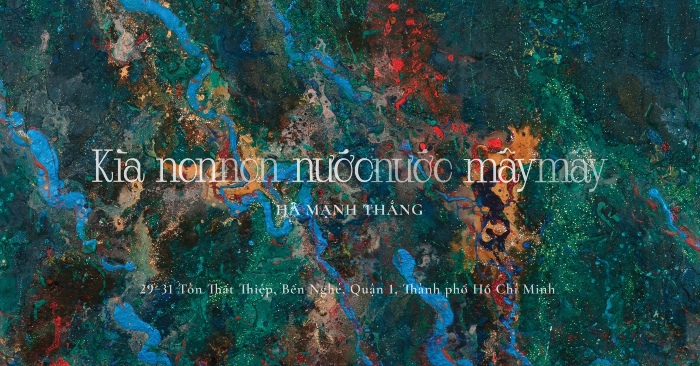Kìa non non, nước nước, mây mây: Solo exhibition by Hà Mạnh Thắng

Tues – Sat, 22 Dec 2022 – 04 Feb 2023, 10 am – 07 pm
Holiday hours: closing at 03 pm on 24 Dec; closed 25 & 26 Dec and 31 Dec 2022 – 2 Jan 2023
29 – 31 Tôn Thất Thiệp, D.1, HCMC
From the organizer:
Galerie Quynh is thrilled to present Hà Mạnh Thắng’s solo exhibition ‘Kìa non non, nước nước, mây mây’ in a 19th-century colonial-style building at 29 – 31 Tôn Thất Thiệp that was once the guesthouse for Sri Thendayuthapani – the Hindu temple located just opposite. As the following chapter of Thắng’s previous solo show at the gallery, ‘The Reflection’, the exhibition features 16 experimental works that illustrate the artist’s continued fascination with materiality, time, and the excavation of history and cultural heritage.
The exhibition title borrows from ‘Hương Sơn Phong Cảnh Ca’ (Huong Son Landscape Song) by the renowned Nguyễn Dynasty intellectual Chu Mạnh Trinh. The poem encapsulates well the complexity of emotions when one is confronted by the magnificence of nature. The same sentiment can also be observed in Thắng’s artistic practice. Over the years he has focused on exploring the polysemic nature of landscape, and the evolution of viewing landscape in art from ancient times up to the present.
On one of his recent trips to the Vietnam National Museum of History in Hanoi, Hà Mạnh Thắng chanced upon an ancient stone stela, which is said to date back to the Sui dynasty (581 – 618). Stone stelae play an important role in recording history and often bear the inscriptions of notable scholars. The stelae carry the weight of cultural heritage – the qualities that make them, in the artist’s words, become “immortal with time and having their own fate.” Hà Mạnh Thắng adopted its shape as the symbol for timelessness and eternity for the works featured in this exhibition.
Instead of stone, Thắng’s stelae are now made of a combination of silk, canvas and a plethora of other media. He sees them not as materials, but as shapeshifting surfaces where textures and transparency change depending on their application. From the back of the painting, the transparency of the silk’s surface changes depending on the light. The painting is placed in a matte opaque plexiglass frame of the same shape making the presence of silk and its transparency even more subtle. Such treatment, as art historian Nora Taylor observes, “turns silk into stone”, begging for the reconsideration of silk’s duality:
How can silk be both transparent and opaque? How can it be both light as a feather and look as heavy as a stone? The dual nature of the universe reveals itself like the opposite forces of yin and yang. And, like scholars’ rocks, Thắng’s paintings offer us a means of contemplating the world in microcosmic form.
Each of Thắng’s stelae evokes landscapes inspired by his favourite poems from monumental works by poets and scholars from the Tang and Song Dynasties in China, and the Nguyễn Dynasty in Vietnam, as well as Tản Đà — Thắng’s all-time favourite pre-modern Vietnamese poet. Poems from these periods are known for using landscape as a metaphor for the author’s contemplations on the meaning of life; where its time and landscape coexist with those of the reader. These poems and what they signify tend to resist the erosion of time. For Thắng, they exist like a non-time element.
These artworks, forming part of the ‘Đối Ảnh’ series, assume the form of a sculpture and a history-laden artefact. When propped on Nguyễn Dynasty-inspired wooden tables, they transform the historic Tôn Thất Thiệp house into a space for the discussion of past legacies and art. ‘Kìa non non, nước nước, mây mây’ belongs to Thắng’s larger series Circle of Time (2016 – present) and reflects his commitment to the theme of eternity and timelessness. It is where art can be a reflection of the past, of the unconscious mind or of lost memories.
Cập nhật thêm thông tin tại trang sự kiện.














